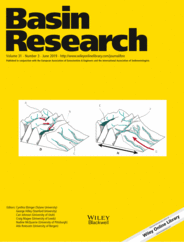
Full text loading...
 , Christopher A.‐L. Jackson1
, Christopher A.‐L. Jackson1 , David M. Hodgson2
, David M. Hodgson2 , Howard D. Johnson1
, Howard D. Johnson1
Strain style, magnitude and distribution within mass‐transport complexes (MTCs) are important for understanding the process evolution of submarine mass flows and for estimating their runout distances. Structural restoration and quantification of strain in gravitationally driven passive margins have been shown to approximately balance between updip extensional and downdip contractional domains; such an exercise has not yet been attempted for MTCs. We here interpret and structurally restore a shallowly buried (c. 1,500 mbsf) and well‐imaged MTC, offshore Uruguay using a high‐resolution (12.5 m vertical and 15 × 12.5 m horizontal resolution) three‐dimensional seismic‐reflection survey. This allows us to characterise and quantify vertical and lateral strain distribution within the deposit. Detailed seismic mapping and attribute analysis shows that the MTC is characterised by a complicated array of kinematic indicators, which vary spatially in style and concentration. Seismic‐attribute extractions reveal several previously undocumented fabrics preserved in the MTC, including internal shearing in the form of sub‐orthogonal shear zones, and fold‐thrust systems within the basal shear zone beneath rafted‐blocks. These features suggest multiple transport directions and phases of flow during emplacement. The MTC is characterised by a broadly tripartite strain distribution, with extensional (e.g. normal faults), translational and contractional (e.g. folds and thrusts) domains, along with a radial frontally emergent zone. We also show how strain is preferentially concentrated around intra‐MTC rafted‐blocks due to their kinematic interactions with the underlying basal shear zone. Overall, and even when volume loss within the frontally emergent zone is included, a strain difference between extension (1.6–1.9 km) and contraction (6.7–7.3 km) is calculated. We attribute this to a combination of distributed, sub‐seismic, ‘cryptic’ strain, likely related to de‐watering, grain‐scale deformation and related changes in bulk sediment volume. This work has implications for assessing MTCs strain distribution and provides a practical approach for evaluating structural interpretations within such deposits.

Article metrics loading...

Full text loading...
References


Data & Media loading...

